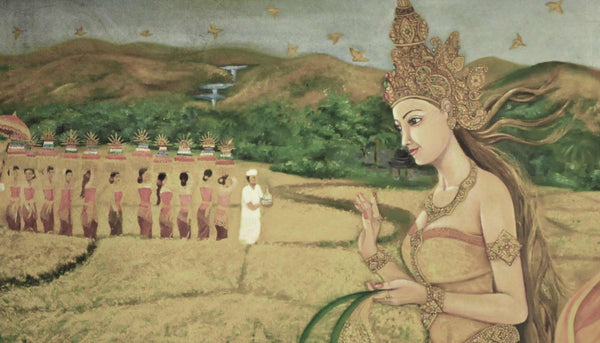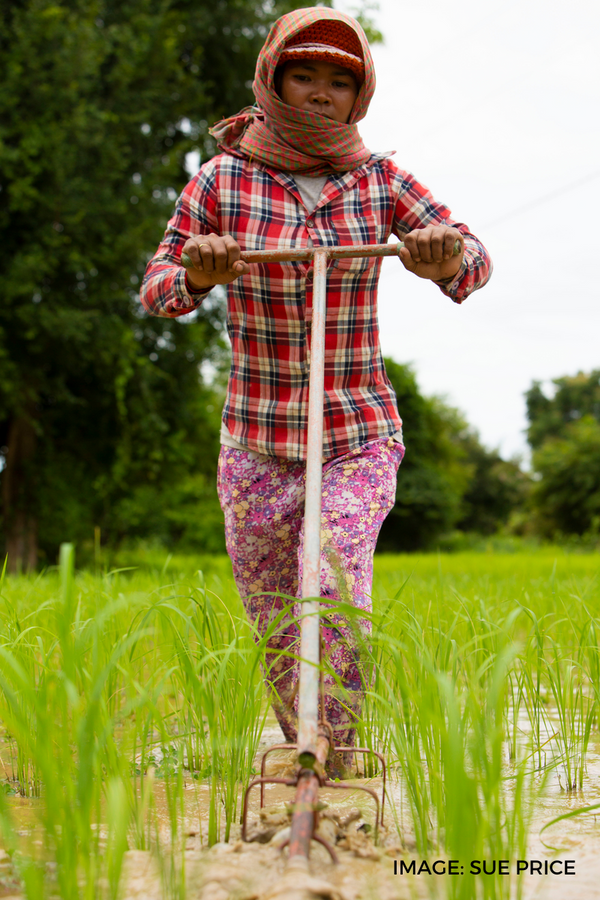Women's Essential Role in Rice
March 7, 2023
Women’s Essential but All Too Invisible Role in Rice Production
Written by Olivia Vent
"We know that we have to work. It is our way of life. We not only work in our fields, also in our homes. In rice season, the workload is so much that we don’t have time to think about it. Since we are farming women, hardly anyone cares about it." - Mami, an Indian woman rice farmer in Odisha state
Indonesian goddess of rice Dewi Sri

"Is there a way of producing rice without experiencing pain in the body?" - Mami
Historically, women were central to the domestication of rice, responsible for much of its biodiversity. Worldwide, there are more women engaged in growing rice than any other livelihood activity: an estimated half a billion women and girls, working on their own farms or as wage laborers. Women’s laboring bodies are thus the human capital required to produce most of the rice eaten in the world, sustaining global food security and nutrition. Yet their resilience and stamina go unquestioned and uncelebrated. Billions of dollars are invested into developing new rice seeds in labs equipped with the most sophisticated technology, and staffed by the most highly educated scientists, with virtually no thought to the women who are expected to put those seeds into the ground and to bring forth food and fodder, most of whom live in poverty.
For centuries, women’s labor in rice farming has remained essentially unaltered. Rice-growing is physically demanding throughout the cropping season. While the allocation of tasks can vary depending on the rice-growing system and region, generally men plow the paddy fields, make bunds around rice paddies to contain water, prepare seedbeds, and apply synthetic fertilizers and pesticides. Women select the seeds, sow and manage nurseries, remove seedlings and transport them to the field, transplant them, weed, harvest, thresh, winnow, clean, sort and bag the grain, process it, and save seeds for the next crop. In addition, women tend other crops, care for livestock, sometimes do wage labor or market small products, collect wood and water, process food, bear and rear children, and care for family members.

Worldwide, there are more women engaged in growing rice than any other livelihood activity: an estimated half a billion women and girls, working on rice farms.
Under prevailing rice production systems, rice is mostly grown in flooded fields and mainly in the wet (summer or monsoon) season. This means that women work long hours in wet conditions, under hot sun or in rain, in standing water, and exposed to numerous parasites, disease vectors, and agrochemicals. They perform repetitive motions in painful postures for hours on end, with the same basic tools such as hand hoes and sickles that they have used for millennia, and this in an age when we have robots mowing our lawns. These conditions practically guarantee chronic illness and pain. When women work as wage laborers, such tasks are considered unskilled and command only the lowest wages. Based on her research in Odisha state of India, my colleague Sabarmatee estimates that each season, women spend four to five hundred hours in bent or sitting positions in flooded fields to cultivate one acre of rice!
By the time a season’s weeding operations are finished, she reports that women are exhausted and fatigued. Besides musculoskeletal pain throughout their bodies, they suffer from skin infections due to prolonged exposure to muddy water. Such infections are worse if agrochemicals like urea or chlorofluorocarbons were applied, intensifying the pain. Many women laborers postpone buying medicine due to urgent household needs for cash for other things. This can exacerbate problems, and more must be spent on treatment later, further diminishing household resources. Sabarmatee also found malnourishment to be highest among women during the rice-growing season.
Women provide 50-90% of labor in growing the world's rice crop.

Women engaged in rice production are mostly overlooked by policymakers, researchers, and extension personnel, and they are under-represented in their access to land, credit, training, and setting development priorities. Little attention is given to what are the impacts that agricultural policies and practices have on women’s health and bodies. While plant breeders are increasingly encouraged to take into account women’s perspective on breeding priorities, there is no comparable investment being made by researchers to explore what could be done to lighten women’s workload or mitigate their risks, especially with regard to the use of agrochemicals.
With men increasingly seeking off-farm work to bring in needed income, women have to take on more of men’s agricultural tasks, including spraying rice crops with pesticides, insecticides, and herbicides. This is referred to now as ‘the feminization of agriculture.’ Women are more vulnerable to the ill effects of these chemicals than men because most of these toxins are stored in body fat, and women often have a higher percentage of this. Chemical pollutants can thus be stored in the body for many years after exposure. Children can suffer the impact of ‘hand-me-down’ toxins during fetal development and later through breast milk. Given the enormous number of women growing rice, this should be a major global health concern. Even modest investments could make a big difference, such as better protective equipment, more training on health hazards and how to handle the chemicals more safely. And ensuring that labels are in languages people can understand, or that warnings are communicated to illiterate women farmers.
Another modest investment would be to train more farmers on the principles and practices of the System of Rice Intensification (SRI). SRI involves changes to how farmers manage their plants, soil, water and nutrient amendments to increase the productivity of rice. With SRI methods, farmers can improve their yields by 50-100% and even more without agrochemicals or new seeds, and with less work and fewer health hazards for women. Rice fields are no longer kept continuously flooded, so women do not have to work in standing water. They have 80-90 percent fewer seedlings to sow in nurseries, uproot, transport, and transplant. And seedlings are not only fewer, but much younger and lighter to carry.

System of Rice Intensification (SRI) enables women to weed fields faster and in an upright posture not bent over for hours.
Since the seedlings are transplanted singly rather than in clumps, and in rows and not randomly, women can control weeds by using a simple mechanical weeder, pushing this between the rows in an upright position. This eliminates the need for backbreaking manual weeding and reducing also the time required. Sabarmatee measured that it takes women around 130-160 hours to weed an acre of rice by hand, moving at an average speed of 1 square meter per minute. Weeding with a mechanical weeder, on the other hand, takes 16-25 hours/acre. And since the weeder is considered a mechanical tool, men often take over this task because operating machines is culturally classified as ‘men’s work,’ so women are freed from this work. For women to benefit from this shift, however, farmers need to have access to weeders, and they should be designed to be suitable for women as well, otherwise new health problems can arise.
Over a decade ago, Oxfam America conducted an investigation in Cambodia of the gender dimensions of SRI. One woman interviewed commented:
We now have more time to look after our children, sew and clean more. We now only spend 1-2 hours in the field. ... We can work during the hours when sunlight is not too strong, unlike in conventional farming, when we have to spend all morning and most of the afternoon in the field.
How transformative it would be if the world took seriously the role and importance of women in producing rice and made it possible for millions more women to experience these benefits.
Source:
“The System of Rice Intensification and its Impacts on Women: Reducing Pain, Discomfort, and Labour in Rice Farming While Enhancing Households’ Food Security,” by Olivia Vent, Sabarmatee, and Norman Uphoff, in Women in Agriculture Worldwide: Key Issues and Practical Approaches, edited by Amber J. Fletcher and Wendee Kubik, pp. 55-75, Routledge, New York (2016).
About Olivia Vent
After two decades in communications for international agriculture, first in the Secretariat of the Consultative Group on International Agricultural Research (CGIAR) and then at Cornell’s International Institute for Food, Agriculture and Development (CIIFAD), Olivia changed direction, working with the US
rice-importing company Lotus Foods. As CIIFAD’s information director, she learned how farmers trained in System of Rice Intensification (SRI) methods were transitioning from rice deficits to rice surpluses, and she became committed to helping find markets for their traditional varieties. Since 2009, as Lotus Foods’ SRI Liaison, she has helped the company establish SRI supply chains in multiple countries. She is especially concerned about raising awareness of the role and challenges of rice-farming women.
More Resources:
Resources
SRI International Network and Resources Center (SRI-Rice)
Women in Agriculture Worldwide Key issues and practical approaches
Consultative Group on International Agricultural Research (CGIAR)
Cornell International Institute for Food, Agriculture and Development (CIIFAD)


